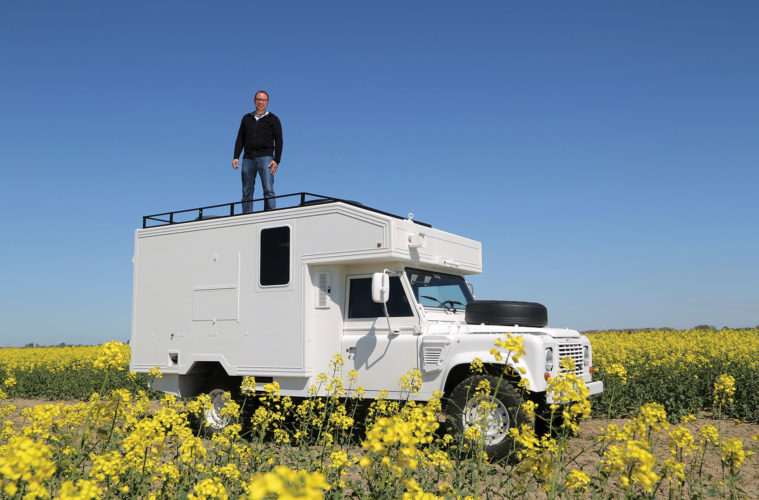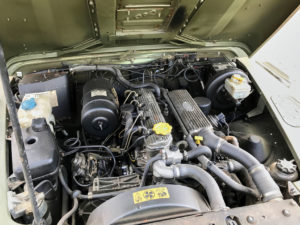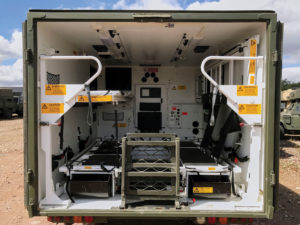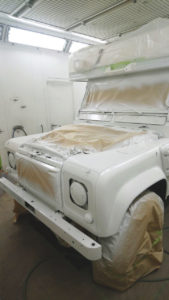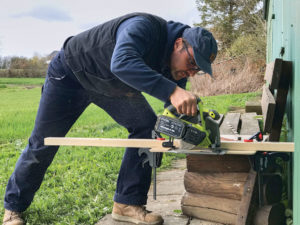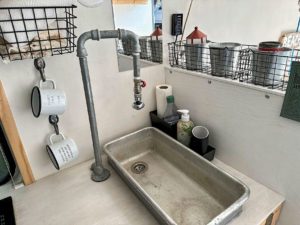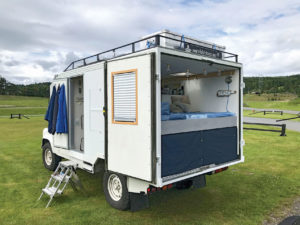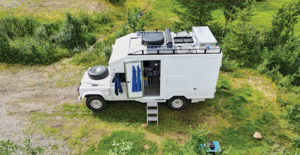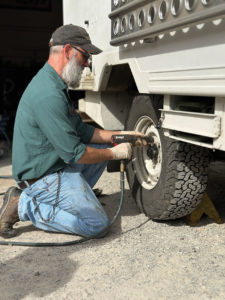This is it!” I said to myself when, five years ago, I saw all the ambulances on that huge property in rural Lincolnshire, about one hundred miles north of London.
I had traveled from my hometown of Hamburg, Germany, to Witham Specialist Vehicles, Ltd, the sales and marketing agent for UK Ministry of Defence (MoD) vehicles, spares and tires. Amidst the helicopters, fire engines, armored vehicles and gigantic lorries, I spied a group of Land Rover 130 Pulse ambulances. “They’re all from 1997, all 300 Tdi powered,” said the sales agent. “In the late 1990s, the British Army had ordered 800 of them from a joint venture between Land Rover and their long-time ambulance partners, Marshall of Cambridge. Nearly all of these ambulances were RHD – only a very small number had been ordered as LHD for their army bases in Germany.”
While many of the RHD vehicles showed the scars of combat in Iraq and Afghanistan, the LHD ones appeared unscathed. “Obviously the British didn’t like them too much and didn’t take them on combat missions,” noted the sales agent. I couldn’t believe my eyes as I read the placard on one windscreen, “Only 55,000 km!” [34,175 miles -ed.] That had to be the one for me.
I have to confess that I knew little about Land Rovers. I knew of the marque, had seen some old films with Series Land Rovers, and had always dreamed of owning a Series or Defender one day. Online research displayed the vehicles that I could convert to a camper for worldwide travel – an idea that grew upon my graduation. Somehow, I had always postponed it to “later.” By 2017, at age 42, I realized that “later” should mean “now.” I was so curious about all the people, cultures and landscapes I would like to discover! The time to begin my travel preparations had arrived, as had my travel companion, this ’97 Land Rover.
This 130 Pulse ambulance ticked off all the right boxes: 4×4, strong and compact, easy to drive and repair, with spares available worldwide and without sophisticated electronics. When I asked to drive it, the sales agent noted a flat tire and batteries too weak to start the engine; a jump start at least demonstrated the engine would turn over. I flew home to Germany, mulled it over during several sleepless nights and finally confirmed the sale. A few weeks and lots of paperwork (concerning the mandatory export license for an Ex-MoD vehicle) later, a tow truck brought my Pulse to Germany.
Now came the challenge of converting the ambulance into an overland camper. Good luck came in the person of Kalie Knause, a mechanic and Land Rover expert who examined the vehicle in his shop. We found the British Army’s Motor Transport fitters had done a terrific job on maintaining the Pulse. Kalle advised, “Never change a running system and don’t replace parts that are working fine.” (His dictum remains one of my golden rules with my Land Rover.) With that in mind, we decided to renew all the fluids and replace the aging Michelin tires with BF Goodrich All Terrains.
Removing the ambulance kit of four stretchers, the Land Rover’s rear box made a perfect base for the camper conversion. Its dimensions of 8½ by 6½ feet would provide enough space for a bed, sofa, clothes and gear closets, and a small kitchen. (The headroom is less than my 6 ft height, however.) I had so many ideas of how I could place all that stuff on my 55 square feet; pages and pages of floor plan drawings. Later, I figured out that I would have to concentrate on just the most important things. I also wanted to keep the total weight down to
below 7,000 pounds.
Lastly, the conversion had to be affordable. The Land Rover purchase had dug deep into my savings. With so many open questions, only one thing became clear; I would have to do most of the work myself to save some money.
The next hurdle was finding shop space in which to work on the Pulse. Luckily, I found I could rent space in an old barn in a little village about an hour away. At that time, I also decided to paint the Pulse white instead of its military green; I doubted that I could make friends in countries where the Army colors signified trouble rather than relief. A friend sprayed the vehicle and mixed in polyurethane flakes, similar to the Raptor paint used in pickup truck beds. White and other light colors became the choice for the interior also, as it makes a tiny space look bigger. Lightness helps create comfort in a small space; I had always dreamt of having a “beach house” on wheels!
I felt nervous about cutting into the roof to install skylights; after all, you have only one chance to not screw things up. Although the rear box came well insulated, I decided to install another layer of insulation on all the walls, ceiling and floor. I retained the door between the drivers’ seat
and cabin and installed an additional door on one of the side walls as a new entrance. The kitchen would have a refrigerator, sink and induction stove for inclement-weather cooking.
I chose to recycle old stuff whenever possible. Discarded pallets provide a source of wood; two former airline trolleys as cabinets. I realized that demands on airplane equipment are similar to those on an overland camper. Everything must be robust but lightweight. I’m proud of the huge sofa I built in the back of the cabin. With both of the back doors wide open, it becomes the perfect spot to chill out and enjoy panoramic views. At nighttime, it converts to a cozy bed. When looking for durable fabric to serve as a mattress cover, I sacrificed some old jeans I had at home.
Traveling would mean a lot of outdoor living – that’s why I installed foldable shelves on the side of my Land Rover. There I can place my gas stove or do some dish washing. I would stow chairs, a table and some more outdoor stuff in a rooftop flat box. The roof rack also holds a water tank for my outdoor shower, and two 100-watt solar panels that charge my onboard batteries.
I worked on the conversion in between jobs, so the entire process took about two years – and then the 2019 Covid pandemic put a halt to my travel plans. Finally, last year, I arranged for the shipping of the Pulse from Germany to Halifax, NS, where I started the drive south toward the USA. I quickly recognized that the banshee-level brake squeal from the rear would frighten drivers and bystanders – and drive me batty.
Land Rover Toronto did not have the brake kit in stock, which baffled me, until I understood the absence of the Defender L316 from the North American market (so different from my European experience). At the advice of Canadian enthusiasts, I checked in with Michael Wesson of Brittanica Restorations, Sherbrooke, QC. The pads, installed before departure from Germany, were likely aftermarket parts, he noted. While the brakes worked fine, I could not live with the decibel level of the brake squeal – nor should anyone in the vicinity of my Land Rover during braking!
Michael recommended the two-hour drive to Rovers North to purchase Genuine Land Rover pads. Not only did Rovers North have them in stock, but thanks to Zack Griswold, I got the right ones. Thanks to Graeme Walford, they were installed for me, and thanks to Mark and Andrea Letorney, I enjoyed Vermont hospitality overnight and the opportunity to share my adventures through future articles in Rovers Magazine.
[You can follow Maik’s adventures at www.aworldfullofstories.com and
via Instagram, @a_world_full_of_stories -ed.]
